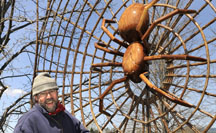May 5, 2011

Photo courtesy NOAA National Severe Storms Laboratory (NSSL).
Take cover: Severe weather reminders
by Paula Van Brocklin
This spring's severe weather has brought death and destruction to a large swath of the United States with nearly 1,000 tornadoes reported in April alone. In central Iowa, we've escaped Mother Nature's wrath so far but there's a lot of spring and summer left.
Here's a quick reminder from ISU's environmental health and safety department and the National Weather Service about how to stay safe from tornadoes, lightning and flooding.
For all severe weather
- Be aware of weather conditions at all times, especially if threatening weather is predicted.
- Sign up for an email or text alert from local television stations.
- If you receive a severe weather message, spread the word to your co-workers and family members, especially those who work outside.
For tornadoes
- If you hear a tornado siren while inside a building, go to a windowless interior room on the lowest level; bathrooms often are best. Avoid buildings with large expansive roof structures, like the Armory. Many campus buildings have designated storm shelters.
- If you are walking across campus and hear the tornado siren, get to the nearest building and follow the same procedures.
- If you are driving a car and debris begins flying around you, pull over and park. Your next two options are:
- Stay in the car and buckle your seatbelt. Keep your head below the windows and cover it with your hands or a blanket.
- If you can safely get to a ditch or area lower than the road, exit the car and lie down in that area with your hands over your head.
For lightning
- All thunderstorms produce lightning. If you hear thunder, lightning is close enough to harm you.
- If you are planning outdoor activities, know where to go for safety and how long it will take to get there.
- Consider postponing outdoor activities if thunderstorms are predicted.
- If you hear thunder, even in the distance, move to a safe place. Fully enclosed buildings are safest. Sheds, picnic tables, tents and covered porches do not protect from lightning. If no safe buildings are nearby, jump in a car (with a hard metal top) and close all the windows. Stay put for at least 30 minutes after the last rumble of thunder.
- Don't use a corded phone while it's thundering and lightning, unless it's an emergency. Cordless and cell phones are OK.
- Don't take a bath or shower (or use any plumbing fixtures) during a thunderstorm since water pipes conduct electricity.
For flooding
- Head to higher ground if a flash flood warning is issued for your area.
- Don't walk through floodwaters. As little as 6 inches of rushing water can sweep you off your feet.
- Don't drive through floodwaters. Most cars can be swept away in less than 2 feet of moving water.
- If you live or work in a flood-prone area, consider gathering emergency supplies, such as:
- A three-day nonperishable food and water supply
- Flashlight
- Seven-day supply of medications
- Copies of personal documents (insurance policies, birth certificates, deed/lease to home, etc.)
- Cell phone with charger
- Tools for securing your home
- Insect repellent and sunscreen
- Extra sets of car and house keys
- Camera to shoot photos of damage to your property
For additional severe weather safety information, go online to EH&S or the National Weather Service websites.
